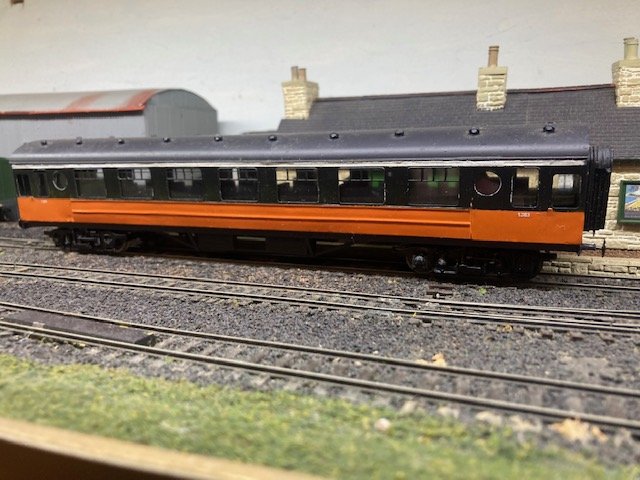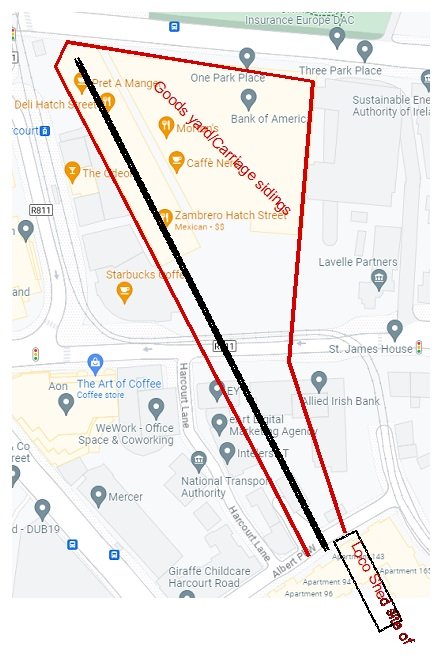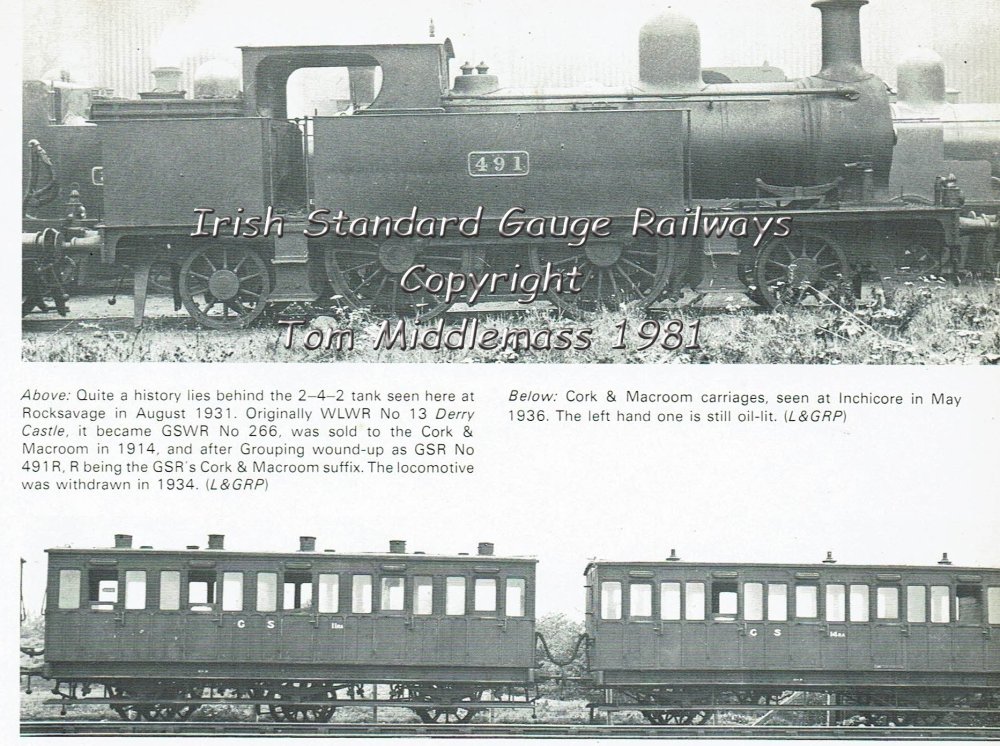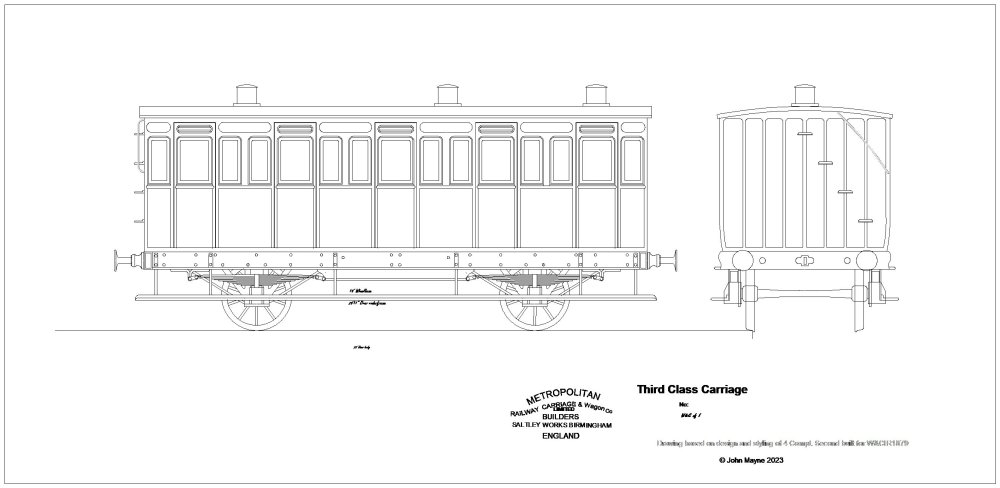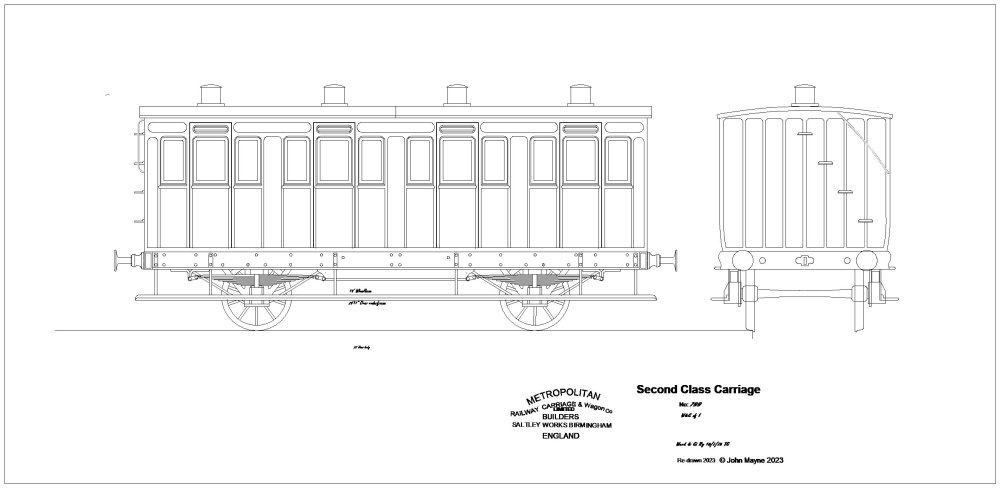-
Posts
4,880 -
Joined
-
Last visited
-
Days Won
119
Content Type
Profiles
Forums
Events
Gallery
Blogs
Community Map
Everything posted by Mayner
-
Photo taken before the station layout was re-modelled in the early 50s when the locomotive shed on the left was demolished, the shed road extended to connect with the Athenry line as the new Platform 3. The light grey buildings in the left distance are pre-cast concrete loco crew facilities installed after Claremorris became the rail head for Knock Pilgrimage traffic
-
I have completed the final revisions to the artwork for the conversion kit and will be placing an order with the suppliers during the next 2-3 weeks currently I have confirmed orders for 4 frets, if anyone else is interested in placing an order please p.m or reply to this thread.
-

Ernies Massive Irish 1930's to 2005 Photo Archive
Mayner replied to Glenderg's topic in Photos & Videos of the Prototype
Woodenbridge Junction was one of the most attractive stations on the system. The add was for Crossley stationary engines often used in farms and workshops which had an excellent reputation. The Crosley engines used in the A and C Class appears to have been an attempt to develop a lightweight 2 stroke engine to give AEI and edge over English Electric and Brush in a similar manner to the use of the lightweight 2 stroke 567 engine gave General Motors an edge over American loco builders that used heavier 4 stroke engines in their locos such as Alco and Baldwin. Western Australia appeared to have overcome the worst of the reliability problems with its Metrovick locos which used the same engine as the CIE A Class. The Australian Metrovicks lasted in service on Perth Suburban trains with their original engines until the lines were electrified during the mid-80s -
While its a nice idea its difficult to envisage a manufacturer producing a wide range of rtr Irish steam locos even where there are common parts between classes, factors include limited demand and price point. The majority of models produced by IRM and MM are focused on the 70s-90s era, reflect the railways experienced by modellers in their 30-50 (largest group and greatest purchasing power) during their formative years, with a very small demographic group in their late 60s onwards having memories of steam in every day service. Although Chinese factories will produce a minimum run of 1000 plastic injection rtr locos or items of locos or rolling stock a contract manufacture would need to sell a minimum of around 3 times that amount at the current British/Irish price point for a similar rtr model. I think the Managing Director of Accurascale (Stephen) spoke about min. sales projected sales of 4000 before producing a loco. A number of Chinese and Korean manufacturers produced rtr metal (brass and nickel silver) models of locos and stock with a limited production run of 500 models which would need to sell at a price point 4-5 time that of an equivalent plastic injection rtr model. Several years ago I looked at commissioning a rtr Irish OO Gauge steam loco direct from a Chinese manufacturer, I would have needed to sell 500 locos with a €5-600 price range to make a profit. Although original pricing was based on a Midland Cattle loco, I would probably produced a GNR S or Compound had sales projections stacked up. OO Works have managed to sell approx. 100 of their Irish locos produced to date about twice the price point of a similar plastic injection loco, though I understand that the UG 0-6-0 which followed their first Irish loco the U 4-4-0 was slow to sell.
-
The scale gauge discussion in Ireland and New Zealand for that matter often revolves around the countervailing arguments of whether its easier to model to an established British Modelling scale and customise the gauge or to use an established gauge and customise the scale to model the Irish/Australian Broad Gauge and NZ/Australian/African 3'6" "Cape Gauge. Proponents of the established scale and custom gauges often argue that that those who choose a custom scale on an established gauge model the track to a different scale to the rest of the model as in 9mm scale on O gauge or S on OO for NZ 3'6" gauge although the track is sometimes handlaid or assembled with correct scale components. A recent local development has been the modeling of 3'6" to American O Scale on S Scale track to take advantage of Bachmann On30 American Logging locos and equipment used on New Zealands Bush Tramways or logging lines. Australians who model (Australian) Standard Gauge in HO tend to use HO on EM gauge track for Victoria and South Australian Irish Broad Gauge, Western Australia, Queensland and Tasmania appear to have gone their own separate ways for modelling their states 3'6" gauge systems with modellers in each state adapting differing scales and standards, which makes producing rtr models of Australasian 3'6" locos and stock extremely challenging commercially.
-
There were no dedicated automobile trains as such in Ireland apart possibly from the train used to transport cars between Rosslare Station ((formerly Ballygeary) and Rosslare Harbour before the introduction of RoRo Ferries during the late 60s/70s. Cars and Tractors were transported as individual wagon loads on open wagons from the Ford Cork plant and other assembly plants to destinations on the CIE system on ordinary goods trains. Dublin plants assembled BMC (Austin,Morris,Wolsey) GM Opel/Vauxhall, Roots Group later Chysler (Sunbeam, Hillman, Talbot, P) VW/Audi, Smiths Group(Wexford) Renault cars. The Ford plant had a siding connection form the Cork City Railway and possibly Smiths at Wexford South, cars from Dublin plants were loaded in the Dublin goods yards. Traffic died out following the introduction of modern double deck car transporter during the late 60s/70s with direct delivery from the Plant or Importers yard to the local dealership or garage. There is a photo somewhere of a late Austin 1300 on a flat wagon at Nenagh but I cannot find the file or a link. The photo on the Provincial Wagons web site is typical of how cars and farm machinery were transported on the Irish railway system https://provincialwagons.com/
-

Narrow Gauge in the Rockies not quite
Mayner replied to Mayner's topic in US / Canadian Railway Modelling
Not another Autumn/Fall Stock Rush! Apart from the Christmas Holidays these days the only time I regularly run trains on the garden railway is during the Autumn or what Americans call the fall. Very little running since the last post mixture of the weather and gammy knees as I get older. I did a major leaf blowing/lawn mowing/leaf clearing exercise on Sunday after an arborist did some tree-removal/canopy lifting on Saturday, trees grow a lot faster in our region than in Ireland and the UK but also die off quicker. I decided to run a couple run a stock train and a freight with K27 2-8-2s 464 and 463 on Sat. afternoon but had to postpone until Sunday afternoon after the coupler pulled out of the tender dragbox on 464 on the empty Stock Special. 464 had earlier rolled over on the High Line just like RGS 455 in 1944 https://digital.denverlibrary.org/digital/collection/p15330coll22/id/61596/ luckily without serious damage (landing in a bed of mulch), was re-railed and continued her journey until the coupling failed on the first stretch of level track! She managed to back her train up to the staging with some manual help, leaving only 348 a small 19th Century 2-8-0 and 463 to work the Stock Train and the Freight as opposed to the two 2-8-2s and the 2-8-0 as planned with the 2-8-2s as train engine on both trains and 348 as "Helping Engine" on the "Hill" In the end it was decided to combine the two trains and run with a helper loco throughout and divide and "Double the Hill" with the return train, although it was dry the rails were greasy and 348 slipped and stalled with 5 cars and a Caboose even on a 2% grade. C19 (16 actually!)348 departing Jackson City with stock cars with K27 463 cut in behind heading the general freight a reasonable representation of an RGS freight in its later days though usually hauled by a pair of hired DRGW K27s 348 is actually an Accuracraft DRGWR K16 bought second hand from the States, the owner had neatly re-numbered as a similar though larger K19. The RGS bought 3 K19s from the Rio Grand during the early 1900s but I am not going to bother changing the livery or running number! Passing the Summit section of the line with the locos on a 2% down grade the train is stretched out over 20' The trees behind the train were bought as 'miniatures" about 10 years ago! 2024-2025 firewood weathering beside the railway. Pulling into Utah Junction where the train will divide and revers before running up the 4% grades of the Highline to the Garage staging. 348 reverses her portion of the train on the Wye at Utah Junction, the recently cut back tail track is just about long enough for 348 and her train. 348 has pulled her train onto the Highline at Utah Junction as 464 pulls her train towards the Wye 464 has pushed caboose 400 onto the stock train before positioning 401 on the main track at Utah Junction 464 left the caboose on the Main Track before leaving her cars on the main leg of the wye before reversing and attaching to 348s train 348 departs with 463 as helper at the rear caboose 402 waits on the Main to be attached to the freight by the Pusher loco. Usually older wooden framed caboose were coupled behind the Pusher loco though some shorter caboose had reinforced underframe and could be coupled between the train and Pusher. I tried to video 348 & 464 with the stock but it was not a success and the train stalled on the grade, 348 and 463 did just about made it with 348 slipping and 463 "digging in" on the hill. 348 tends to slip when overloaded, but with the "chuff' sensors on the tender axles just goes quiet, though 463s sensors are on a driving axle axle the loco just stalls when overloaded. https://youtu.be/bCuaEICTlbM -
Smokebox & Front Footplate The smokebox former is designed in two parts to reproduce the distinctive extended smokeboxes fitted to some classes of locomotives re-built with superheated boilers. The bolts fitted to the main section of the former are intended for bolting the smokebox to the boiler-firebox assembly and the running plate, the bolts fitted to the extended section are basically alignment pins. Smokebox fitted to boiler-firebox Original 2013? smokebox fitted to boiler-firebox: It was necessary to remove a section of the wrapper that fouled the driving wheels on the original wrapper one of the inherent problems when you are unable to scale down full size gauge and running clearances in a model. Frames and running board compromises TMD/SSM J15 The frames on the SSM/TMD J15 are designed in two sections in order to reproduce the open section between the rear of the buffer beam and the front of the cylinder block at the front of the loco and to allow the model to be assembled to a narrower than prototype gauge and or compromise wheel standards. This feature was absent on locos re-built with new deeper mainframes by the GSR including the preserved 186. I did not notice this feature when I produced the original fret, but included it on the revised version. The revised mainframes are modelled full length and include a half-etch line (viewed from the rear) for modelers who intend to assemble the frames in two parts in accordance with the original TMD/SSM instructions. The chassis is designed with half-etched lines for hornblock cut-outs and fluted coupling rods! Work in-progress with Saturated J15 with McDonnell linkage reverse built 1860s-1900, Post 1900 Saturated "Coey" J15 with raised sandbox, revised cab and direct reversing lever, Superheated J15 original frames and linkage reverse. I expect to complete the amendments to the fret and place orders for the production fret by late next week with a 6 week lead time to delivery. From a personal modelling perspective next job is to complete the artwork for the large capacity Type B tender to run with the Coey J15 on the Limerick-Sligo goods and assemble a Type A tender to run with the Superheated loco, an even bigger challenge will be to sort through my stock of J15 parts for boiler fittings and buffers to complete the two locos and where required order replacement parts.
- 3 replies
-
- 12
-

-

-
I designed a fret for converting the SSM/TMD kit into the Z Boilered superheated version of the loco about 10 years ago. I assembled two J15s from TMD kits during the 80s-90s picked up a part built kit at Expo EM about 20 years ago and bought a further two kits from Paul Greene shortly before he sold the business to Des Sullivan during the late 2000s. Apart from the MM 201 and repaints of BR stock reasonable rtr models of Irish locos and stock were virtually unknown and apart from the SSM/TMD available kits were nothing to write home about. Although mainly interested in the Midland I basically gave up on scratchbuilding during the 80s and I was planning to build a model of Kiltimagh and the J15 were the staple motive power on Burma Road goods trains so I ended up with 5 J15s and decided to build one as a superheated loco to add variety. The original fret was very simple basically heavier main frames fitted to some locos by the GSR smoke box and firebox parts and a new spectacle plate. Additional parts were included to replace the fragile brake gear and reversing rods and Belpaire firebox formers similar to that used in the Y Boiler version of the JMD 650 Class kit. Although I gained considerable experience in designing loco and rolling stock kits over the past 10-12 years, I ended up with a 12 item snag list after I completed the test assembly of the firebox, boiler and smokebox after I converted a 2D design into a 3D object. The first boo-boo was forgetting to attach the half etched smokebox wrapper to the main fret and I appear to have "disappeared" a copy of the original fret complete with wrapper! The main design change in design from the original fret is to include a former/jig for forming the firebox and bolt together assembly of the three main sub assemblies. I removed the center section of the former/jig once I soldered the wrapper in place. I was reasonably satisfied with the fit of the wrapper, though those fragile sandbox rods are a pain! The cab and running board for the loco were assembled about 10 years ago! I have designed the firebox-boiler-smoke box to bolt together using 10BA bolts. There may be variation in the diameter of boiler wrapper in individual kits supplied by TMD and SSM, the kits supplied by Terry McDermott in the 80s-90s were supplied with boilers formed from brass tube, the boilers wrappers in the two kits supplied by SSM in the late 2000s were rolled from sheet brass and were marginally larger in diameter. I will cover the smokebox assembly and modifications to the running board in a separate post.
-

Ernies Massive Irish 1930's to 2005 Photo Archive
Mayner replied to Glenderg's topic in Photos & Videos of the Prototype
Most likely 455. According to a "Decade of Steam" 456 was scrapped early in 1955 (boiler/firebox problems) 457 (large yellow numerals on her side tanks) was transferred to Limerick shortly after the arrival of the diesel electrics and ended up as Goods yard Pilot, 455 remained on the DSER "very run down but still defiantly pounding up Killiney Bank with her six bogies of "Commuters" " -

mgwr preserved railway Connemara Railway project.
Mayner replied to ttc0169's topic in What's happening on the network?
When I was living and working in London during the late 80s-early 90s a work colleague used to take the Sleeper on Friday evenings after work to go mountain biking in the West Highlands, often spoke about waking up and looking out over Rannoch Moor in contrast to the frantic pace of life in London, he used to return on the Sleeper Sunday evenings always arriving on time at work on Monday mornings. We were all young and wild then thought nothing of it used to drive on a 400+ round trip every other weekend to go volunteering on a Welsh narrow gauge railway it was a point of honour to arrive in our destination before pub-closing time on a Friday evening and stay up half the night, these days I don't know how I managed to survive! -
Typical CIE passenger train of the 1950s-80s similar in outline but no two vehicles alike! Nearest the camera 1964 Built 6w Heating Van 1356-1371 Series Open Second/Standard-----CIE 1951-54 Stock best described as a MK2 Bredin GSR Bogies constructed using traditional coach building techniques-definitely not a Laminate. 1372-1378 Series Corridor Second/Standard--CIE 1951-54 stock: on Bulleid Triangulated Underframe with Commonwealth Bogies Built 1954. An earlier batch of these coaches 1356-1371 had conventional steel underframes and ran on GSR bogies----definitely not a Laminate Possibly a 1958 built 1449-1496 Series Laminate Open Second/Standard. These were CIE largest/most common type of second/standard class coach during the 50-70s used mainly on main line duties before the introduction of the Supertrains in 1972 The CIE 1951-54 Stock were built using traditional coach building techniques welded steel underframe, timber framed bodies with aluminium body panelling with cover slips. The Laminate bodies were modular construction using composite panels Aluminium skin-Insulation (asbestos?)-Plywood internal lining allowing high volume semi-skilled construction. Interestingly CIE reverted to traditional coach building techniques for it last 100% Inchacore built coaches in 1962-4 1145-1146 Superstandard/First Class and 1444-1448 Second/Standard which ran on Bulleid Triangulated underframes with BR style Commonwealth Bogies. While British Railways designed and built literally thousands of MK1 coaches for all its Regions during the same period CIE built/assembled three different coach each using totally different coach building techniques.
-
IRM/Stephen, Fran, Patrick's excellent customer service approach makes good business sense and is one of the key principals of Total Quality Management. Looking back over the events of the past 10-12 years what impresses me most is IRM 'founders" strategy of setting up and funding the add-free Irish Railway Modeller news group as a vehicle to promote interest in Irish railway modelling, which in turn provided a springboard for the launch of IRMs first model the CIE Ballast wagon, the directors had the capability to commission the models directly from the Chinese factories without an intermediary after DJ stuffed up, the quality of the first model and doing business directly with the Chinese factories provided the spring board to expand the IRM range of Irish models and more importantly from a business perspective launch Accurascale and enter the UK market, a text book example of business start up and expansion.
-
Looks better equipped/organised than the East Wall Rd depot during the 70s-90s era when most of the yard was full of cripples/redundant stock. Given the DSER theme how about a spur from the DSER line south of the Dodder into the Ringsend area and a rail connection to the container terminals on the South Bank of the Liffey.
- 8 replies
-
- 3
-

-
- tolka sidings
- micro layout
-
(and 1 more)
Tagged with:
-
Definitely interested in the CIE Commonwealth bogies if released separately for my Worsley Works Laminates and Park Royal. Wonder how my Park Royal (not bad for a 1st attempt at a brass coach) will compare with the new IRM models BR (BSGV)Vans (34 total) were mainly used on Intercity trains with mixed Craven, Park Royal and Laminate stock. Dutch vans (10 total) tended to be were less common (less popular with Guards) on Intercity Trains. CIE also converted 18 older coaches into TL BSGVs during the mid-late 70s to replace Tin Vans on outer suburban and branch line trains. Apart from a suitable BSGV Van the main item missing to model a conventional 1972-1987 era CIE Intercity train is a Buffet Car.
-

Pen - Y - Bryn NG7 & Conway Falls OO9
Mayner replied to Irishswissernie's topic in British Outline Modelling
Explored Penmachno Quarry once and sometimes used the road over the Denbigh Moors and through the Penmachno Valley as a 'short cut" driving from Scotland to Portmadoc. Model seems to follow the route of the NWNG Bedgellert-Betwys-Corwen scheme hopefully someone will bring out a rtr model of NWNGR single Fairlies Snowdon Ranger or Moel Tryfn Funnily enough I was thinking of a similar WHR minimum space layout with Bachmann Baldwin, Kato England loco and Quarry Hunslet based on an junction at Nant Gwynant between the General Undertaking and a line from the South Snowdon Quarry but I already have more than enough on my hands -
I love your nicely organised workbench, tools and fixtures, mine looks more like a scrapyard! Nice work with the piercing saw.
-
Harcourt Street would be extremely ambitious for a first layout particularly if your planning to scratchbuild a model of the station building which would be a major project in itself. Its probably best to consider what aspects of model railway do you enjoy the most before deciding on the type of layout and space available. Harcourt St, Milltown Viaduct and Dundrum Station would take a lot of space, time and effort to build in OO, but would fit in half-three quarters the space in N. The station while relatively compact in length (excluding the fitting between Albert Place and Hatch Street, the was almost as wide with the carriage sidings/goods yard fanning out half the distance between Harcourt Street and Earlsfort Terrace. The late Desmond Coakham published an excellent article in the Harcourt St line in CIE days which includes photos and trackplan of Harcourt St. Railway Byelines Annual No5 published Irwell Press 2002 who may be able to help.
- 58 replies
-
- 3
-

-

-
- 1950s to 1990s irish railways
- harcourt street line
- (and 3 more)
-
I remember a priest working himself into a lather during a sermon (the late 60s) about how the World was coming to an end, after seeing a young couple and not being able to recognise the difference between the sexes because they were both wearing long hair and denim jeans. I was only a kid at the time, but it of those lightbulb moments about not believing everything your told by people in authority
-

If you want to maintain your track on your layout...
Mayner replied to spudfan's topic in Letting off Steam
Many years ago a model railway club member remarked that the only thing missing was a Kango Hammer as the O Gauge group carried out track laying on a new layout. The group went about their tracklaying with as much finesse as a full scale track gang using a full size hacksaw and 20oz hammer to lay and pin down Peco Flexi-track. The larger the scale the closer you get to the real thing I use a graphic paste for lubricating the rail joints on the Garden Railway though its supplied in a small tube by LGB rather than a 5 or 10 Gal drum by RS Clare https://www.rsclare.com/wp-content/uploads/2020/09/RS-Clare-Rail-Brochure.pdf -

Ernies Massive Irish 1930's to 2005 Photo Archive
Mayner replied to Glenderg's topic in Photos & Videos of the Prototype
I am not sure if TPOs ran on the WLWR line, at the time the daily Limerick-Sligo train was usually operated as an AEC railcar set, the Limerick-Galway train was a loco hauled (A Class) Mail based in Limerick possibly with a TPO. The late 50s built Bogie and 4W TPOs may have struggled to provide cover for all mail trains before the line closures of the 1960s Possibly a cripple shunted out of a train (especially with the net) en-route from Limerick Works to Sligo or Athenry, ex MGWR TPOs appear to have been in use on the Midland until the (very) early 60s. -

route feeding track power on DC layout using relays
Mayner replied to raymurph's question in Questions & Answers
Stewart Hine wrote about "route feeding of track power" as "Linked Section Control" in Model Railways Magazine during the 1970s, I had tried variants of the system using relays and manual switches on a number of layouts down the years. I am not convinced that the accessory switch on the Seep PM 1 would be reliable enough to operate the relay. I use a similar "route-feeding" arrangement using "Blue Point" manual point controllers https://ppw-aline.com/collections/blue-point-manual-turnout-controller using push rod control, on a small end to end layout eliminating the need for section switches or a control panel. The "Blue Point" has a built in DPDT switch, I use one pole for section control using common return wiring, the second to change frog polarity with live frog points, the power is routed "backwards" through some of the points which are controlled using manual push rods (bicycle spokes) I use hand held controllers (1 Gaugemaster, 1 custom made) which plug in to DIN sockets on the layout fascia 1 socket for main and 1 socket for yard working. I will probably use a similar system using the accessary switch on Tortoise point motors http://www.circuitron.com/index_files/tortoise.htm for power routing if I get round to building a new layout. -
There is a photo of a Macroom 4w 5 Compt. coach coupled to a Macroom 6W 5 Compt coach in "Irish Standard Gauge Railways Tom Middlemass 1981. Curiously the 4 wheeler appears to have been fitted with gas lighting at some stage (by the GSR or GSWR?) while the 6 wheeler retains oil lighting. The panelling detail above the windows on both the W&CIR and Macroom coaches appears similar possibly with Metropolitan supplying coaches to both the W&CIR and CMDR
- 45 replies
-
- 6
-

-
My impression of a W & C I Rly five compartment Third Class Carriage based on the Metropolitan drawing of the 1879 Second. Apart from the harder seats ,Third Class passengers would have had less legroom than those that could afford a First or Second Class ticket with an internal compartment width of 4'10" and poorer lighting with 4 compartments sharing two Oil Lamps. In GSR days the Macroom had a 5 compt. 3rd with a similar lighting arrangement though with gas rather that oil! I will place higher-resolution copies of these drawings in the resource section.
- 45 replies
-
- 7
-

-

-
Although mainly interested in the Midland I bought a copy of a GA drawing of a WCIR 4w "Second Class Carriage" to get a better understanding of the type of 4 wheel carriages bought by Irish companies during the 70-80s. There is also a more modern WDLR 4w brake in the catalogue which is probably next on the list. I decided to "colour-in" the drawing to give an impression of the WCIR 'lake livery' and provide some contrast between the paneled areas and mouldings, I tried to re-produce the graphics in a similar style to the 1879 original The coach had an overall body length of 25' on a wheelbase of 14' a similar length to the WDLR Brake and 4 compartment 4w coaches built by the GWR in the early 1900s. The most interesting thing about the coach is the absence of brakes! the coach was introduced long before power braking and block working became compulsory. . The coach is listed on the drawing as 799 (a worker or order number) no other order numbers are listed on the drawing, its difficult to establish at this stage whether the coach was a one off or part of a larger order. I suppose the next job is to re-draw the coach a 5 Compartment third.! The panelling style on the ends is not dissimilar to the 4W van coupled behind No 12
- 45 replies
-
- 7
-

.png.c363cdf5c3fb7955cd92a55eb6dbbae0.png)




